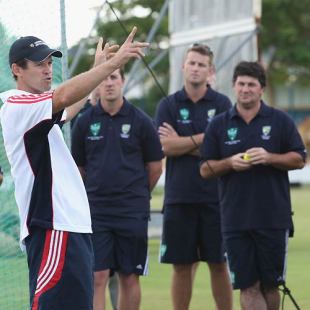Thrown in at the deep end
What does swimming have to do with cricket? More than you think when it comes to coaching
09-May-2008

| ||
At an elite cricket coaching course this week one of the main speakers was a swimming mentor. And not just any swimming mentor. Alan Thompson is in charge of Australia's Olympic team. Ninety-five days before the lighting of the flame in Beijing he talked to a bunch of cricket specialists during a break from the gold, silver and bronze dreams of his 42 charges. The night before Phil Mooney, the Queensland Reds rugby union coach, had addressed the group.
There was no confusion over the purpose of the course. It was about cricket, but it centred around coaching people. Australian cricket's development in this area is the envy of the world - although England offers a higher qualification through a university course - and every sport, corner and research paper is analysed to see whether it will uncover new ground for the game.
So listening to a presentation about how talented swimmers aged between 15 and 32 come together as a team for the most important event of their lives is not so outrageous. It is an opportunity to learn about elite athletes and sport. Even after a full day spent grappling with information overload from in-depth sessions on batting theory and implementation, teaching skills and advanced skill acquisition (acquiring an understanding of what that meant was a bit much for one external observer; attendees needed to have already attained level one and two certificates), space was saved to absorb Thompson's messages.
Hearing how the millionaires of the swimming squad fly in economy class and share rooms with team-mates who rely on their parents for money created ideas about how to fit people together in any squad. While Australia's national players travel towards the front of the plane and it is one person per hotel booking, most of the coaches in the Ian Healy Room at Queensland Cricket's Brisbane headquarters deal with more restrictive budget conditions. Moulding their teams and fitting everyone in, they believe, is essential for collective success.
At one side of the Cricket Coaches Australia seminar is Darren Lehmann, a decorated international player who has fallen back in love with the game since retiring, and is adding to his already impressive knowledge base. "It's a real eye-opener, it's bloody amazing," he says. "Level three is the finishing school where you learn the latest trends and techniques to be a good coach."
Behind Lehmann is a replica scoreboard of Queensland's drought-breaking Sheffield Shield triumph in 1994-95. When Lehmann's eyes wander he can see he made 62 during the the innings-and-101-run defeat. Mark Harrity, the former left-arm fast bowler, sits a few spots further down from Lehmann in the room and on the board. He is an assistant Under-19 coach at South Australia, who also sent Greg Blewett, who played 46 Tests, to the course.
| Hearing how the millionaires of the swimming squad fly in economy class and share rooms with team-mates who rely on their parents for money created ideas about how to fit people together in any squad. While Australia's national players travel towards the front of the plane and it is one person per hotel booking, most of the coaches in the Ian Healy Room at Queensland Cricket's Brisbane headquarters deal with more restrictive budget conditions | |||
"All the techniques we're starting to learn, profiling people, working out how people tick, I look back at how I went about things and wish I knew some of that information then," Blewett says. "I would have got more out of myself if I knew myself better. I'm more of a natural player. I go out and play rather than thinking about whether I'm holding the bat too tightly."
The current first-class representatives involved are Dan Marsh, Nick Jewell, Adam Griffith and Andrew McDonald, while coaches from Pakistan, Sri Lanka and Zimbabwe are among the group of 37. McDonald, the Victoria allrounder, has been on the fringe of Australia's contract list for the past two seasons. He helps out with Victoria's junior elite squads and wants to learn the state-of-the-art information for himself - and his students.
"I've been bombarded with a hell of a lot of information and I'll probably use it to review my own game," he says. "I've got a hell of a lot of notes that I need to go through, then look to implement them on the youngsters, finding out what works and what doesn't. Down the track maybe I will learn what will work with my game."
During the opening day there was a session with Dene Hills, the national assistant, on batting, when they saw a simple underarm-and-catch drill that Ricky Ponting uses when he is looking to find his touch. Tim Nielsen, the national coach, was another to spot his name on the Queensland scoreboard as he outlined his planning for the upcoming West Indies tour, and his support staff delivered lectures on fielding, technology, physical conditioning and biomechanics. The six-day programme, which finishes today, seems to cover everything.
Over at Swimming Australia the aim is to align four "cornerstones" for their sport: clubs, coaches, kids and champions. Cricket Australia also realises the importance of the helpers and mentors, from the scorers at junior games to the level three coaches eyeing first-class and national appointments. The cricket specialists at the course - the ex-Test players, the women's internationals, the state assistants and the treasured club members - still felt a bit strange to leave the opening day with the words of a pool expert swimming in their minds. "Coaches have a big responsibility," Thompson told them. "They can light the fire or put it out. Remember your responsibilities."
Peter English is the Australasia editor of Cricinfo